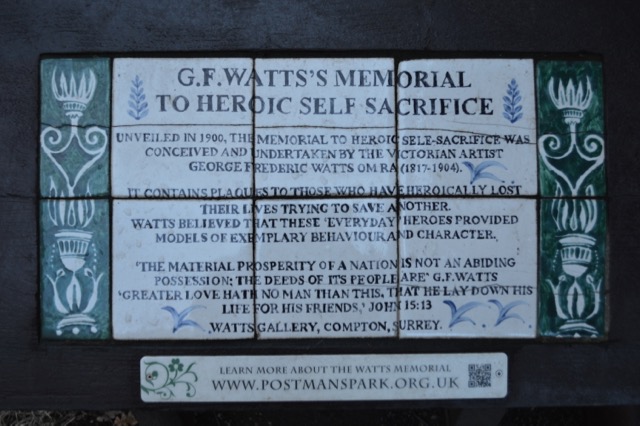Post
#WhenThisIsAllOver | Matt Brown | The Londonist
29 Apr 2020
How should we commemorate the heroes?
Matt Brown suggests how we might pay lasting tribute to key workers who lost their lives to coronavirus.
At the time of writing, at least 20,000 British citizens have lost their lives to Covid-19. London hospitals account for around a quarter of those deaths. The virus has caused the greatest disruption to society since the Second World War. Although it’s hardly the most pressing question right now, I can’t help but wonder how the victims of the pandemic will be remembered by wider society. And I have an idea, which draws inspiration from our city’s past.
London is replete with memorials to the great and good. We have more than our fair share of moustachioed military men on horseback, but these are vastly outnumbered by plaques and statues to those who contributed to society without the need for imperial equestrianism. These were otherwise ordinary people, who did something extraordinary. Heroes who dedicated, and sometimes sacrificed, their lives to help others.
Postman’s Park in the City of London contains one of the capital’s most famous, and certainly most thought-provoking, examples. In this quiet, unassuming space stands the Memorial to Heroic Sacrifice -- sometimes called the Watts Memorial after the painter George F Watts who proposed the idea. Opened in 1900, its 54 glazed tiles record the names and deeds of individuals who died while saving others.
Here we read of Alice Ayres, the 25-year-old nursemaid who saved three children from a fire but lost her own life to the flames. Of 61-year-old Daniel Pemberton, who pushed a rail worker out of the way of an oncoming train, but was hit himself. And of 19-year-old William Donald who drowned in the River Lea while trying to save a boy from “a dangerous entanglement of weed”. Most recently, a tablet was added for Leigh Pitt, who drowned while rescuing a boy from a Thamesmead canal in 2007 -- the first addition to the memorial wall since 1931.
Over the years, the memorial has attracted far more attention than any bronze general or sandstone statesman. Its stories, told in simple, powerful language, still move the reader, decades after the awful events they describe. The wall of memorials has appeared in Hollywood films and countless press features, and is a popular stop-off point for tour-guides. Above all, this is a living memorial that has only gained in potency through the generations. It is the best kind of monument.
London needs a new Watts Memorial, one that records the sacrifices of our own generation. Hundreds of thousands of Londoners continue to put themselves at greater risk of infection, either on the medical front line or by turning up for work in another key service. At the time of writing, 21 London transport workers have lost their lives, while over 100 medics and carers have succumbed to the virus across the UK. Delivery drivers, shop assistants, teachers, prison staff, emergency service workers and other key workers have also died. We can expect more.
The Watts memorial can serve as a powerful template for how we might commemorate some of these lives. Among its heroes, we find similar professions to those mentioned above. Several are medics. Dr Samuel Rabbeth, for example, saved a four-year-old diphtheria patient by sucking an obstruction from the child’s blocked airway, in doing so exposing himself to the fatal disease. Two of the tablets memorialise ‘carmen’, what we might today call delivery drivers. Another remembers two transport workers who were badly injured in a boiler blast, but managed to bring their train to a safe halt.
Like the selfless people remembered on the Watts memorial, the key workers taken by coronavirus died while helping others. They may not have leaped in front of speeding cars or pulled anyone from quicksand (as did one of the carmen mentioned above), but their actions -- in serving the public at greater personal risk -- were nevertheless heroic.
All kinds of memorials will be suggested over the coming months and years, but I hope that those 54 cherished tiles in Postman’s Park may serve as an inspiration.
Matt Brown is editor-at-large of Londonist.com and author of Everything You Know About London is Wrong, among other books.
WhenThisIsAllOver is the London Society's debate about what the post-virus, post-lockdown world will and should look like. Contributions so far include:
- Chris Williamson | Weston Williamson + Partners | Change is needed
- Clare Richards | ft'work | Local is central
- James Raynor | Grosvenor Britain and Ireland | We need system change
- Freddy Mardlin | London’s Outside Space
- Andrew Beharrell | Pollard Thomas Edwards | Reevaluation
- Amy Warner | Appreciate More
- Mike Stiff | Stiff + Trevillion
- Lord Toby Harris | London will need fresh purpose
- Matt Brown | How should we commemorate the heroes?
- Peter Murray in conversation with Robert Elms
- Prof. Samer Bagaeen | Create a resilient economy
- Neil Bennett | Farrells | High Streets must Act or Die
- Buckley Gray Yeoman | How can design respond?
- Alistair Barr | Bring production back to the West End
- David Morley | There's only one Way
- Chris Williamson | Getting back to work
- Nicholas Falk | URBED | The suburban battle grounds
- Roland Karthaus | Matter Architecture | Institutional architecture in a time of crisis
- Jonathan Manns | Rockwell Property | Planning for #WhenThisIsAllOver
- Daniel Moylan | We need to stop telling people what to do
- Dr Meredith Whitten | We need a green infrastructure
Please give your views in the comments below, or by emailing blog@londonsociety.org.uk
